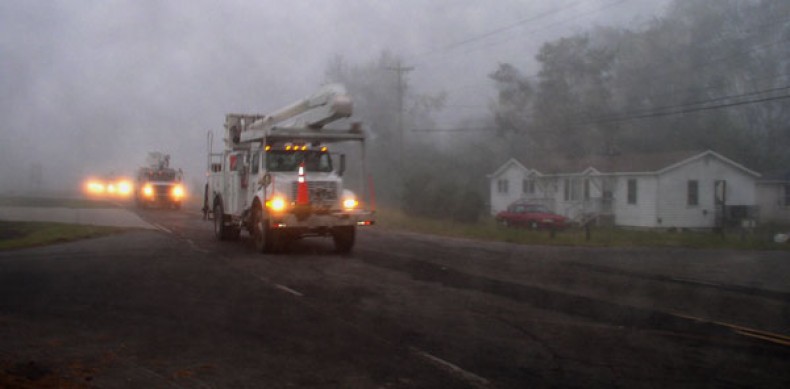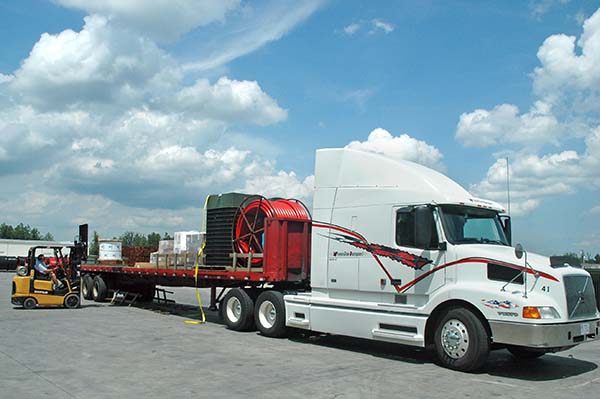Help is on the way
The cooperative mutual aid response after major power outages

When a power outage occurs, electric cooperatives these days increasingly are employing advanced communication technology to determine, in many cases, where the outage is and which services are out. New technology can even find out where faults occur on power lines. It's a major advance from the days when co-ops relied solely on member phone calls to report outages (or postcards in the days before everyone had telephones).
But the work involved in restoring your electric power still involves dispatching a crew to repair the problem.
Over the years, North Carolina's electric cooperatives have continually analyzed how they respond to outages so that they can improve the process where needed. The drill has been refined to the point where its smooth, efficient operation is a source of pride among co-ops. The response procedure is similar among electric cooperatives nationwide, but each region has its own policies and practices, mainly because weather, terrain and demographic distribution can vary.
What happens after a major outage?
It actually begins before a major outage if the cooperatives see a forecast for a major storm that could cause widespread outages. Co-ops increase their inventory with supplies that may be needed after the storm event, and all staff is on alert.
In North Carolina, The Tarheel Electric Membership Association (TEMA) assists in arranging for mutual aid through the sharing of line and service personnel among the cooperatives. It is one of many services offered by TEMA, a member-owned central materials supply cooperative formed by all the state's co-ops in 1975. Lonnie Moore, TEMA's senior vice president and chief operating officer, describes what happens when systems go down. He operates with his "storm bible," the Emergency Work Plan, followed by all the state's cooperatives.
"When we know a hurricane or ice storm is coming," he says, "we start building our inventory. We increase the amount of material we know is likely to be damaged: poles, conductor, transformers and crossarms. We encourage our members to do the same."
The Emergency Work Plan includes detailed information about each cooperative's system: their system voltages, details on their infrastructure, what gear, equipment and vehicles they have.

The state’s electric cooperatives formed The Tarheel Electric Membership Association (TEMA) as a central materials supply cooperative. Based in a 120,000-square foot warehouse north of Raleigh, TEMA helps coordinate response to major power outages.
Then, Moore says, "We're in touch with emergency contacts at the co-ops. The co-ops in harm's way know that we are just a phone call away, that we're here if they need us."
Where systems are damaged, the co-ops know that TEMA's material shipments cannot begin until it's safe and practical to transport them. "A loaded semi is not going to be able to get up a steep incline ramp that's all ice." However, material shipments begin the minute it is safe enough to travel.
Co-ops that escape damage are on alert that other co-ops may need their assistance. This does not apply just to North Carolina cooperatives. TEMA is a member of a mutual aid system composed of 21 states — from Pennsylvania to Florida, from Michigan through Iowa and Oklahoma to Texas. The co-op emergency responders from these states meet each year to review their process and refresh their contacts. They are immediately in touch by conference call leading up to and after a major storm affects their states.
After the storm passes, co-op personnel assess the damage and determine what they will need. When co-ops ask TEMA for help, they are prepared to report what kind of help they need, how many crews, what kind of crews (tree crews, line construction crews), where the crews should go to await instruction, how many days they likely will be needed, and who their main contact is. Lonnie Moore contacts the co-ops nearest to the trouble area that can offer crews to those in need. Crews are then dispatched. Members of the statewide Job Safety & Training department, who are trained in co-op line construction and distribution systems, may also go to assist line crews in restoration and safety procedures.
Once TEMA makes all requested connections between co-ops in need and those able to provide assistance, "we turn our attention to the material shipments required for restoration work," Moore says. The co-ops manage their own restoration work. Co-op management makes arrangements for visiting crews. In most cases, they already have reserved blocks of hotel rooms and notified local restaurants or caterers.
Co-ops themselves are responsible for the cost of assistance, which is mainly travel and work time, overhead, lodging and meals. Co-ops may also have their own arrangements with contract crews experienced in repairing electrical systems, as well as contract tree crews.
Moving the equipment
Besides coordinating assistance among co-ops, TEMA also provides supplies and equipment for power restoration. The Raleigh headquarters north of the city is in a modern, 120,000-square-foot warehouse. During emergencies, the 17-member staff is on duty shifts around the clock for as long as needed, writing work orders, assembling materials, coordinating trucking lines, and loading trucks.
TEMA streamlines or combines equipment delivery, so that trucks carry supplies to co-ops along a route as expeditiously as possible.
"Seasoned people at the co-ops know what they will need after one of these events," Moore says. Early in the event, however, TEMA may ship more materials than initially called for. "Experience has shown it best to have too much than not enough," Moore says. "And we are always willing to take it back if it's not needed."
Catastrophic damage, or what Lonnie Moore calls "unforeseen events" like a tornado or vandalism, may require specialized equipment: spare power transformers, generators, even a mobile substation owned by the cooperatives' statewide office that works from a flatbed trailer. TEMA will assist as requested in locating and delivering this specialized equipment on a case-by-case basis.
Getting the job done right
Once the visiting crews are no longer needed, the host co-op notifies TEMA that they are "released." TEMA contacts the management of the released crews for permission to send them to another cooperative in need if requested or to return home if not.
An advantage to this system of power restoration is that electric cooperatives throughout the nation work from the same power line specifications developed by the federal Rural Utilities Service. That means visiting crews are already familiar with the construction requirements and equipment, as though they are working on their home systems. This enables line and service personnel to work more efficiently and safely.
North Carolina's electric cooperative crews have helped co-ops recover from disasters throughout the South, operating under the same system of coordination they follow here. After a power outage, there's no scene more welcomed than a truck convoy of line crews coming in to help.
Moore also knows another advantage of this system. "Co-op linemen are the best," he says. "They know what they're doing and they have a work ethic unlike any other. They understand the members' needs, respect the member's property, and treat each consumer as the member-owners that they are."
Moore acknowledges that every storm or event can bring surprises, requiring crews and operation managers to plan and operate on a moment's notice. "It can be what we could call 'complex,'" he says. "But the co-op family does a great job at responding to major outages and, speaking for everyone at TEMA, we are so very proud to be a part of it."
-
Share this story:



